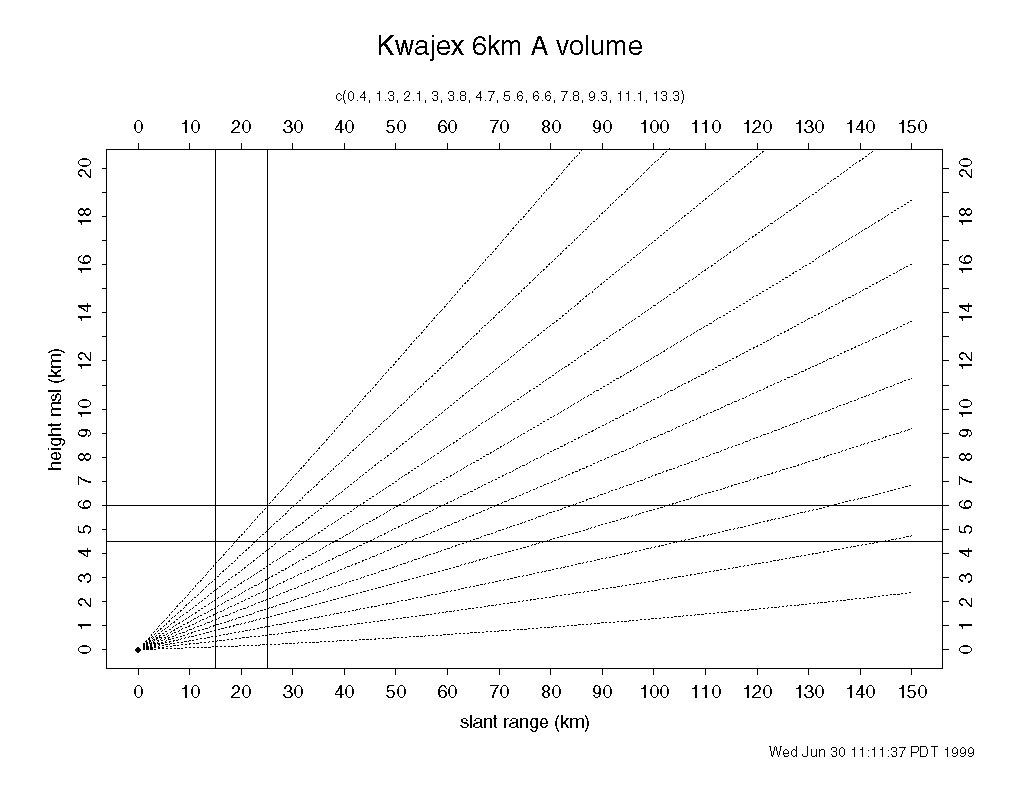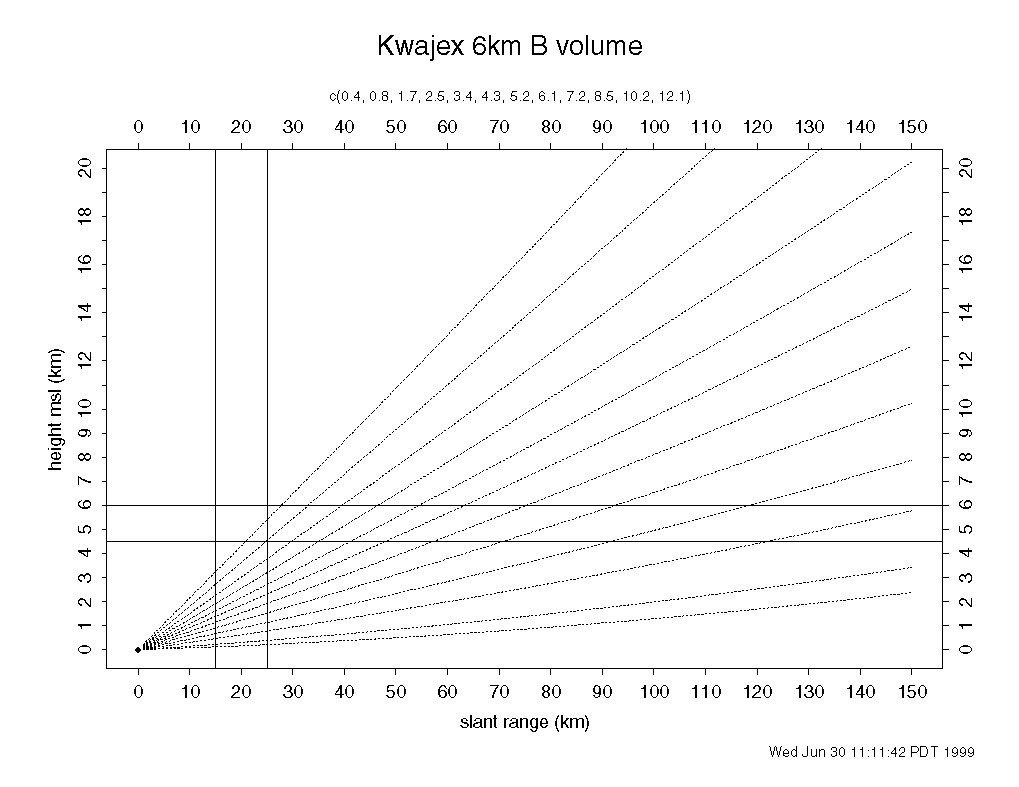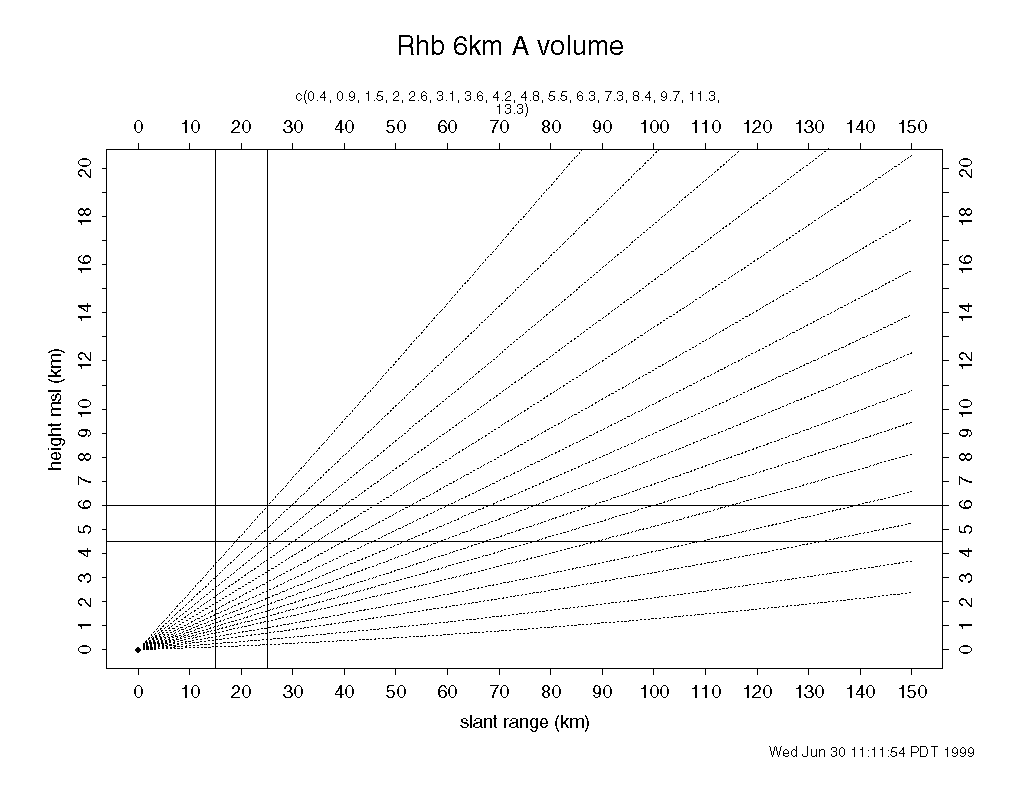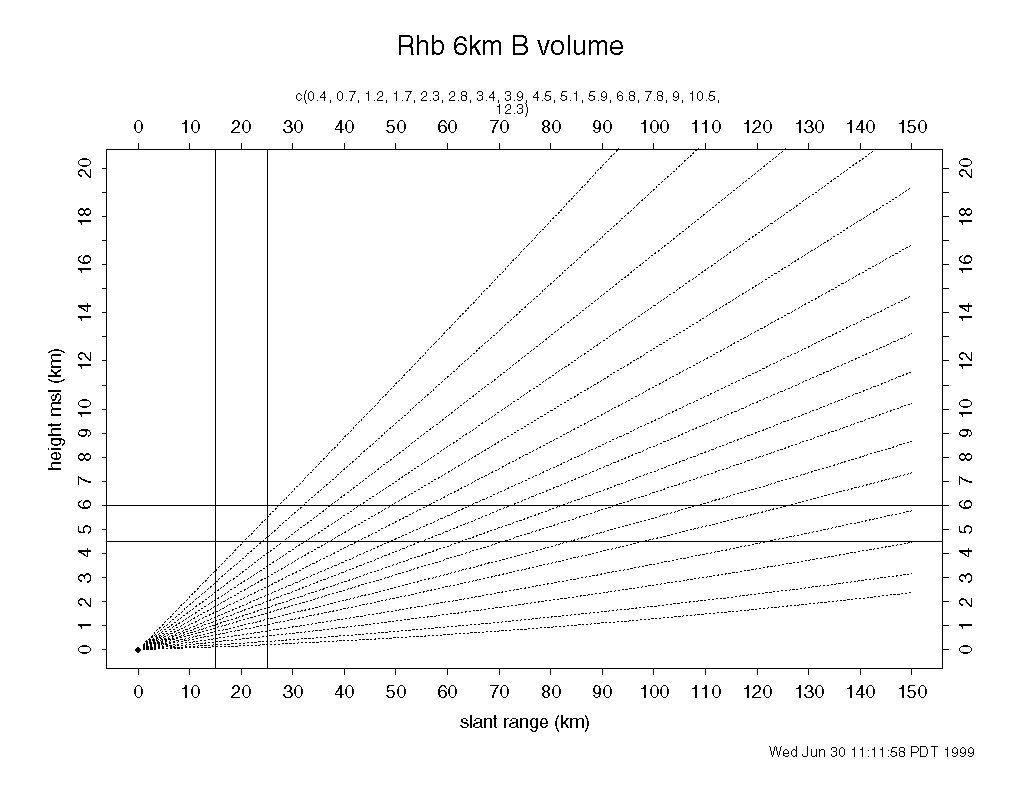



7.3, 8.4, 9.7, 11.3, 13.3
6.8, 7.8, 9.0, 10.5, 12.3
At the 5 April 1999 meeting at Goddard, the general design principles of the KWAJEX dual Doppler scan strategy were finalized.
The Kwajalein S-band radar has been upgraded to include simultaneous transmit and receive at horizontal and vertical polarizations. The maximum PRF of the Kwajalein S-band radar is 960 Hz and the minimum PRF is 396 Hz. Given the joint constraints of dual polarization sampling, PRF and obtaining ~60 hits per sample, the suggested maximum scan rate is 15 deg/sec which translates to 12 elevation angles in a 5 min volume.
The RHB radar has a maximum PRF of 2100 Hz and does not collect dual polarization data. Collection of radial velocity data which does not require extensive unfolding in pre-processing for dual Doppler analysis is a priority for KWAJEX. Given the tradeoff between Nyquist velocity and max unambigous range, the suggested max PRF is 1200 Hz. To obtain ~60 hits with 1200 PRF requires a scan rate of 20 deg/sec which translates into 16 elevation angles in a 5 min volume.
It is proposed that the two 5-min volumes have interleaved angles so that their data can be combined to form a single higher resolution volume. Although not useful for high time resolution dual Doppler analysis, such combination of volumes to form a higher resolution volume may be particularly useful in analyses that can tolerate 10 min volumes such as VAD and dual polarization analysis. The bottom tilt of both of the interleaved volumes is the same so that products based on the lowest tilt such as rainmaps, conv/sf maps etc can be done with a consistent data set. If interleaved volumes are not desirable, please indicate a preference whether volume A or volume B should be repeated twice.
To keep the radar volumes in sync, it is proposed that the details of the task schedule be as follows for each 12 min repeat: 00 start first 5 min volume, 05:30 start 2nd 5 min volume, as soon as 2nd 5 min volume finishes, do surveillance scan.
Conditions at Kwajalein are such that 2nd trip echo is a common annoyance and source of error in the GV data stream. RPHASE processing is a new method of processing the radar signal which Sigmet has developed that removes 2nd trip echo within the unambiguous range. RPHASE was used successfully during the recent JASMINE cruise on the RHB. It creates some spurious data at the unambiguous range but does remove the 2nd trip echo within the unambiguous range. It is proposed that RPHASE processing be used on the RHB during KWAJEX. For the Kwajalein S-band radar there may be a tradeoff such that RPHASE and dual-polarization data cannot be collected at the same time, I am waiting to hear back from Sigmet since I have received conflicting info on this.
Scans were computed using the NCAR Scan Optimizer for each radar and each of the four echo top heights. Data from the ship and Kwajalein radar will be used both in combination and separately in the coming years. Rather than match spatial resolutions which would constrain the ship data set to the lower resolution of the slower scanning Kwajalein S-band, the scans were computed for each echo top in a manner to obtain the best vertical resolution data from each radar given the other scan constraints. The assumption is that data can always be degraded to a more coarse resolution if needed.
It is understood that all proposed scans will need to be programmed and fine-tuned in the field. The scans below are proposed as Version 0 of the KWAJEX scan strategy to facilitate discussion of how best to meet the KWAJEX scientific objectives within the already finalized general design philosophy above.
| Name | variables | deg/sec | # tilts | # samples | pulse
width (usec) |
max
range (km) |
PRF
(Hz) |
Nyquist
velocity (m/s) |
|---|---|---|---|---|---|---|---|---|
| Surveillance | Z | 8 | 1 | 50 | 0.72 | 378.5 | 396 | NA |
| 5 min Volume | Z,Vr,ZDR,PHIDP | 15 | 12 | 64 | 0.72 | 156 | 960 | 25.7 |
| Name | variables | deg/sec | # tilts | # samples | pulse
width (usec) |
max
range (km) |
PRF
(Hz) |
Nyquist
velocity (m/s) |
|---|---|---|---|---|---|---|---|---|
| Surveillance | Z | 5 | 2 | 50 | 2 | 240* | 250 | NA |
| 5 min Volume | Z, Vr | 20 | 16 | 60 | 1.2 | 125 | 1200 | 16.1 |
* Technically, max range of 250 PRF scan is 600 km. 240 km refers to estimate of usable range. At 240 km range center of beam is at 5 km and beam is ~ 4 km wide.
For each
echo top height, 4 scans are shown.
Two for the Kwajalein radar labeled "Kwajex" and two for the RHB radar
labeled "RHB". All the Kwajelein radar volumes have 12 tilts and all
the RHB volumes have 16 tilts.